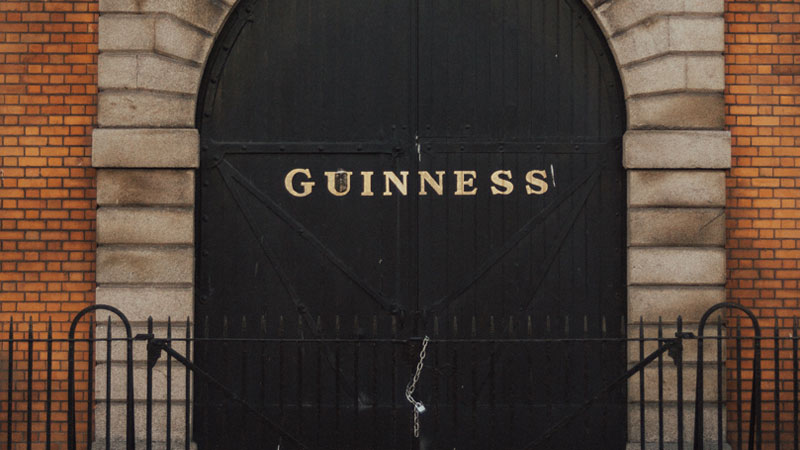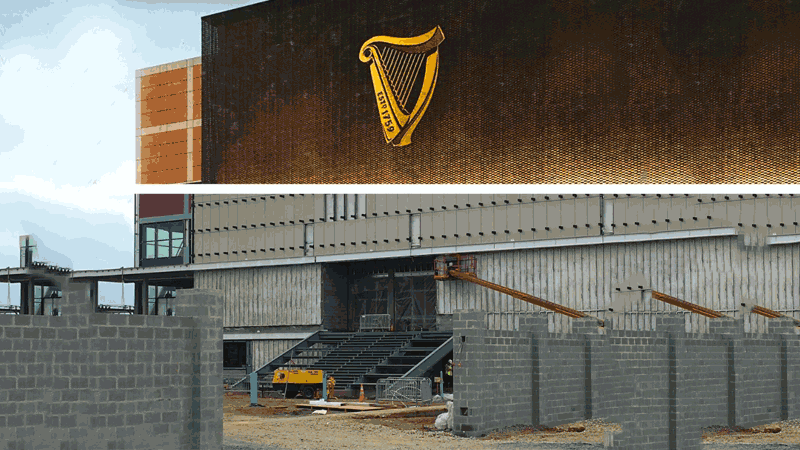Let’s get one thing out of the way: Classic Guinness stout will not be brewed at the company’s new brewery opening just outside Baltimore this Friday (Aug. 3). No, that operation will remain in Dublin, where the water, the history, the Irish knowhow, or something similarly romantic makes it taste just right.
But the new Guinness Open Gate Brewery & Barrel House will brew Guinness beer in America for the first time since 1954. The brewery focuses on experimental, small-scale beers and one-offs, and will be the new home for the company’s Blonde American Lager, currently brewed in Pennsylvania.
The focus is more on innovation, experimentation, and building tourism than on actual production. There is a test taproom offering draught options brewed in Maryland like Crosslands Pale Ale, Milk Stout, and Black IPA — in addition to classic Guinness Draught, imported from Dublin.
Don't Miss A Drop
Get the latest in beer, wine, and cocktail culture sent straight to your inbox.The taproom is currently open to the public, and the company says some 30,000 people have visited since it debuted in October 2017. This reporter can personally report that, on a blazingly hot late-June afternoon, the taproom was indeed full of locals stopping in for a pint or two and a wood-fired pizza from a food cart parked just outside before heading home for the day.
The operation sits in Halethorpe, Md., in a space formerly occupied by Seagram’s Calvert distillery, which Diageo purchased in 2001. The site has been humming with activity all summer, with construction crews working up to 24 hours a day to get everything ready for this week’s opening.
The brewery team is headed up by a seasoned trio of beer industry vets: brewmaster Peter Wiens, formerly of Stone Brewing; head brewer Hollie Stephenson, of Stone Brewing and Highland Brewing Co.; and senior brewer Sean Brennan, of Stone Brewing and Jolly Pumpkin. Diageo is investing $80 million in the brewery, which it says will create about 200 jobs for the local community.
“The correlation between Dublin circa 1759, when Guinness was founded, and Baltimore are many,” says brewery ambassador Ryan Wagner, who also happens to be the public address announcer at Camden Yards. “Both are blue-collar communities with very hardworking people. The people that come to this test taproom by and large are people that work in this community.”
In addition to the test taproom, there will be a restaurant, a second bar/taproom, and visitor center offering a literal window into onsite brewing operations.
“What this brewery allows us to do that we’re not able to do in Dublin is test market,” Wagner says. “We can test beers with our 10-barrel system, and then, if we want to, send it to the 100 hectoliter and scale up and send it further afield.”

The small brewing operation in the main building will provide a space for the team to work on beers like Guava Wit and American Wheat Beer, a far cry from the familiar classic Guinness. These will be sold at the taproom and possibly released in limited quantities to the surrounding community. If something strikes a chord, production can be scaled up in the much larger 100-hectoliter brewery for a more expansive release.
The new brewery will also age a fair amount of beer in wood, an obvious choice given Diageo’s access to millions of barrels from its many whiskey distilleries. The Dublin-brewed Antwerpen Stout is being aged in Bulleit barrels just behind the taproom.
“Our beer has a huge historic presence in terms of wood and barrels,” Wagner says. “St. James’ Gate at one point had one of the largest cooperages on earth. We want to take that historic aging profile and background and bring it up to this new era. We’re hoping this will be one of the largest barrel aging facilities in this country.”
There certainly is the real estate for it, as the buildings currently being revamped and retrofitted were formerly Seagram’s warehouses specifically built for aging whiskey.
According to Wagner, Guinness joined the Brewers Association of Maryland as soon as it possibly could, in 2017, and the company is eager to play a part in boosting the local beer community. Many local breweries seem to be pretty upbeat about Guinness’s return to American soil.
“We welcome Guinness to brewing in the United States with open arms,” George O’Neill, director of sales and marketing for Colorado’s Breckenridge Brewery, says. Owned by Anheuser-Busch InBev, Breckenridge brews its own Irish stout. That classic Guinness won’t be brewed in Baltimore might contribute to his positive outlook.
Heavy Seas, another brewery in Halethorpe, is also extending a virtual welcome wagon. “We are very happy to have Guinness opening near us soon,” founder High Sisson says. “We think they raise the bar for local beer tourism, and I think they add some additional credibility for the Maryland beer industry as a whole. Glad to have them as our new neighbor.” (It should be noted that Guinness collaborated with Heavy Seas on a pair of Belgian ale-based beers in 2017, so the two breweries are starting their relationship off pretty amicably.)
Less than 14 miles away lies Hysteria Brewing, in Columbia, Md. Hysteria’s marketing and events manager, Gina Mattera, says she believes the new brewery will help to promote beer tourism. “Guinness is a well-known name that will attract various beer drinkers from around the country and even the world,” she says. “Our head brewer loves to brew stouts,” she adds. “We would be all for a collaboration.”
Of course, it’s not all happy thoughts and hugs among the local beer community. Tim Scouten, founder of Goonda Beersmiths and brewing operations manager/brewer at Peabody Heights Brewery, says that at the moment Guinness’s arrival is a “net negative” for Maryland breweries. He believes Diageo’s influence in getting legislation passed to help with beer distribution in Maryland was outsized and entirely self-motivated.
“They dance a fine line between wanting to contribute to and help local breweries, and also get laws they need passed to operate,” he says. “We are all welcoming to more competition, especially that of the quality they are likely to produce. What I don’t appreciate is the blurring of lines between what is local and independent (most breweries in Maryland), and the multinational beer and liquor company that is Diageo.”
Scouten believes that Guinness entered the local craft beer scene like a bull in a china shop, determined to help push through legislation to benefit its own interests over those of the local beer community. Most craft brewers are fiercely proud of their independence, and their reaction to what they perceive as a big multinational corporation entering the scene and throwing its weight around can be negative, to say the least.
The legislation Scouten is referring to is Maryland House Bill 1052, which was introduced in February and ultimately did not pass. The bill set higher limits for onsite consumption at larger breweries, while reducing the amount allowed at smaller breweries.
Scouten calls this bill “the legislative ‘big guns’ hollow backhanded bill to further restrict our abilities to operate because of the backlash they got from 1283.”
Maryland House Bill 1283 was introduced in 2017. It “increased the annual barrel limit for taprooms but was met with blowback from many craft brewers, who argued the limitations were still too restrictive,” Amanda Yaeger wrote in Baltimore Business Journal earlier this year.
After backlash from the local beer community about its effect on visitation hours, 1283 was revised to help smaller breweries by raising the production limit to 3,000 barrels annually. It also allows contract brewing where part of a taproom’s brewing can be done offsite.
In February, Guinness issued a statement saying that it did not support 1052 and that 1283 was “true compromise legislation.”
“We will work closely with other Maryland brewers and the legislature and governor on initiatives that support this very important industry and help grow tourism for the state of Maryland,” Dwayne Kratt, Diageo’s government affairs director, says.
Scouten says that if Diageo is helpful in getting bills passed for things that local breweries have desired for a long time, such as self-distribution, expanded production, and higher volume in tasting rooms, the Maryland beer community may look back on this moment as a positive. “I will be the first person in line to say thank you,” he says.

Guinness’s goal is to appeal to American craft consumers, offering micro-style brews from a major global player.
“We want people to recognize Guinness as a brewery, not just a single beer,” says marketing manager Oliver Gray. “If you look at our tap list menu now, we have 11 beers brewed onsite and only three from Dublin. So we want to pay homage to the classic beer that everyone knows and loves, but this gives us a chance to flex our muscle.”
Recent history shows how the line between craft brewers and large corporations is becoming increasingly blurry. There is clearly reason for craft brewers to be vigilant about protecting their own interests and to fight the good fight when legislation is proposed that is perceived as harmful.
That said, there is some validity to the rising tide concept. For those thirsty for change, Guinness’s new endeavor could help lift Maryland’s smaller breweries onto a larger stage.
